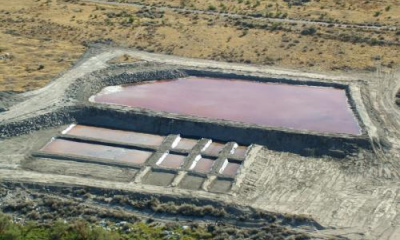From meeting the demands of future growth to protecting over-tapped aquifers, cities provide complex and compelling reasons to recycle their wastewater, even if it further imperils Utah’s shrinking inland sea.
A bill meant to keep some of the only water guaranteed to reach the Great Salt Lake flowing — treated wastewater — may have inadvertently spurred a flurry of water reuse applications across the basin.
Currently most of Utah’s largest reclamation plants sit near the shores of the imperiled lake or Utah Lake, which is connected to the Great Salt Lake via the Jordan River. The facilities clean water flushed down the drain from homes, businesses and industries, then discharge it into canals or rivers that reach the lakes. But more rigorous treatment standards meant to prevent toxic algal blooms have resulted in pricey upgrades for those reclamation facilities. Those costs, along with a rapidly growing population, have cities and water districts eyeing treated wastewater for reuse, either on lawns or, in some cases, as a new drinking water supply.
That makes sense in places like Las Vegas, Phoenix or southern Utah communities like St. George. But for the Great Salt Lake, it could be a death sentence.
“Every drop we reuse, if depleted from the system, only aggregates to the problem of a shrinking lake,” warned Rep. Casey Snider, R-Paradise, during last winter’s legislative session.
If municipalities across the lake’s watershed were to reuse and fully deplete their wastewater, the lawmaker said, the Great Salt Lake could drop another 10 to 12 feet.
“We’d be, in effect,” Snider said, “cutting off our nose to spite our face in the Great Salt Lake system.”
He convinced legislators to approve HB349 in March, which bars the Division of Water Rights from approving any new water reuse applications for projects that would have otherwise discharged to the Great Salt Lake or its tributary rivers.
The bill does include some exceptions. Water reuse proposals designed specifically to supply water to the lake get a green light. Projects which include water rights owned by the federal government have an exemption. And, crucially, proposals filed before Nov. 1 can move forward.
State regulators have since seen a deluge of water reuse applications. Before 2023, officials with the Division of Water Rights only had 25 reuse projects cross their desks in about as many years. About a third came from southern Utah communities outside of the Great Salt Lake basin.
But from March until Nov. 1 this year, the division had 45 water reuse applications filed. All but one came from counties inside the lake’s watershed.
[View a spreadsheet of water reuse filings in Utah with links to applications]
“All the efforts we’ve made to save the Great Salt Lake, it’s going to take some time for any of them to make a big dent,” said Brigham Daniels, a professor at the University of Utah S.J. Quinney College of Law. “But if all these reuse applications are going to be approved, that’s going to make a big dent in the opposite direction.”
It’s hard to say how much water the reuse applications would deplete or remove from the Great Salt Lake and its tributaries. The cities and districts use different methods of calculating and some of the paperwork is incomplete.
Most indicate wastewater will get reused on lawns and crops. The Division of Water Rights estimates outdoor irrigation depletes between 40% and 60% of the water used, while the rest would trickle to groundwater or eventually reach streams.
Some of the applicants claim their water rights allow them to deplete every drop, however, so they’re simply taking full advantage of those rights. The state engineer, who helms the Division of Water Rights, has approved those arguments in the past, but sometimes she only allows a certain percentage of the water to get depleted.
It all depends on the underlying water right, a division representative said.
While the justification cities and districts make for water reuse are complex, and perhaps compelling, Daniels, who specializes in environmental and water law, said cases can also be made against their approval, even if they met the November deadline.
“There are some tools in the agency’s toolbox,” Daniels said, “to look at these with a demanding eye.”
For one, Utah owns its water, which it doles out to users in the form of water rights, which must then be put to a beneficial use. State code allows the state engineer to deny a request if it would harm the public welfare. And depleting more water that would otherwise reach the Great Salt Lake, turning it into a toxic dust bowl and source of endangered species listings, is arguably not beneficial or good for the welfare of Utahns.
“Whether the state wants to go there, I don’t know,” Daniels said. “This really is challenging the state’s role as steward of the water.”
Utah must also manage the Great Salt Lake itself and some of its tributary rivers for the good of all Utahns. A lawsuit is currently pending that attempts to preserve the lake using this principle, called the public trust doctrine.
“They have good chances for denial of some of these permits,” Daniels said. “This is going to have to be done in a much more careful way than I’m able to armchair it from afar.”
But any incomplete applications should get rejected, the professor said.
“I would take a firm stance,” he said. “You had until Nov. 1. If you’re incomplete, we’re done.”
Why cities and public utilities want to reuse Great Salt Lake Basin water
Gov. Spencer Cox closed much of the Great Salt Lake’s watershed to new water rights last year, so growing cities must get creative as they search for new supplies.
Cities and districts within Utah County filed 17 reuse applications this year, more than any other county. Ten of them came from the Timpanogos Special Service District.
Richard Mickelsen, general manager, said he began considering reuse as a way to meet the demands of growth about five years ago.
“The House bill [HB349] forced everyone to the table,” he said.
Booming Vineyard is of particular concern, he said. That city is poised to build a massive dense-use development called Utah City at the site of the old Geneva Steel site. Mickelsen is exploring the idea of piping treated wastewater to the Lake Side Power Station so it frees up culinary water to meet Vineyard’s needs.
At the north end of the watershed, in Box Elder County, Brigham City wants to reuse its wastewater outdoors to also free up more culinary water and support its ballooning population.
“Obviously, we are concerned about the future of the Great Salt Lake,” said Public Works Director Tyler Pugsley. “That being said, we’re also concerned about providing a safe, dependable drinking water supply.”
In the ski and second home hot spot of Ogden Valley, Wolf Creek Water and Improvement District plans to tap treated wastewater to solve its water shortage issues, which it will store in a pond. The district had to place a moratorium on new water connections last year due to a prolonged and crippling drought, which caused waves across the valley. The pause also meant the district faced litigation from landowners who bought home sites in good faith.
“The reuse pond, it solves that problem,” said Miranda Menzies, who chairs the district board. “And it also means we’ve got a source that’s reliable, that doesn’t fluctuate as much in dry years.”
Wolf Creek further argues its water right is part of the Weber Basin Water Conservancy District, which in turn inherited its water rights from the U.S. Bureau of Reclamation — and federal rights are exempt from HB 349. They can also be fully depleted.
Weber Basin has had its own large reuse project in the works for several years. It plans to recycle up to 8,800 acre-feet. An acre-foot is about enough water to support two households in Utah. It will blend that water with storage in Willard Bay reservoir, which captures the last of the Weber River’s flow before it reaches the Great Salt Lake.
Some of the reuse water will get released to the lake, the district’s application notes, and some will meet obligations to support Ogden Bay Waterfowl Management Area, one of the largest engineered wetlands complexes on the lake.
The district is working on a pilot to build a treatment plant nearby as well, which will treat Willard Bay water to drinking standards.
“We just have a lot of demands on our water resources,” said Darren Hess, the district’s assistant general manager. “Development continues to take place. It’s a big balance for us.”
Recycling the water for indoor use, however, means impacts to the lake will be minimal, Hess said.
“Most of that water returns back to the system after it’s used in the home,” he said. “Really, it’s the outdoor irrigation that’s detrimental.”
South Davis Water General Manager Jake Ferguson, however, worries about reductions in outdoor watering, especially as the state now requires meters on most secondary connections. Studies show meters result in 20%-40% less water applied outdoors, meaning more water gets stored in reservoirs but less percolates into the soil.
“We’re wanting to reuse water ... so we can possibly recharge our groundwater in this area,” Ferguson said. “We need that secondary water in the ground.”
As aquifers recede, Ferguson worries the lake’s salty groundwater will begin to encroach and spoil municipal supplies as well. Overdrawn aquifers have caused saltwater intrusion in coastal and interior states since at least the 1970s.
“Water reuse,” said Bryce Haderlie, Woods Cross city administrator, “is one element of contributing to the overall health of the Great Salt Lake Basin water cycle ecosystem that includes groundwater.”
He added the city’s aquifer has already dropped by multiple feet. Woods Cross has partnered with South Davis Water on a reuse proposal.
“The health of the lake is both waters above and below ground,” Haderlie said. “Our goal is to conserve the groundwater and reuse water that has already been pumped.”
The Great Salt Lake basin’s largest city, Salt Lake City, did not file any reuse requests in 2023. But it did receive approval for an application in 2021. The project mostly uses treated wastewater at the Salt Lake City Public Utilities reclamation plant for equipment maintenance and some landscaping.
The application notes the plan will deplete 560 acre-feet from reuse, but Tamara Prue, the city’s water resources manager, said most of that will go to dust control as it builds its new facility. She expects construction to wrap in 2026, at which time depletion will drop significantly.
The department also intends to officially dedicate its wastewater return flows to the Great Salt Lake.
“That’s what happens now anyway, it’s not a change in practice,” Prue said. “But hopefully it sets a model for other cities.”






